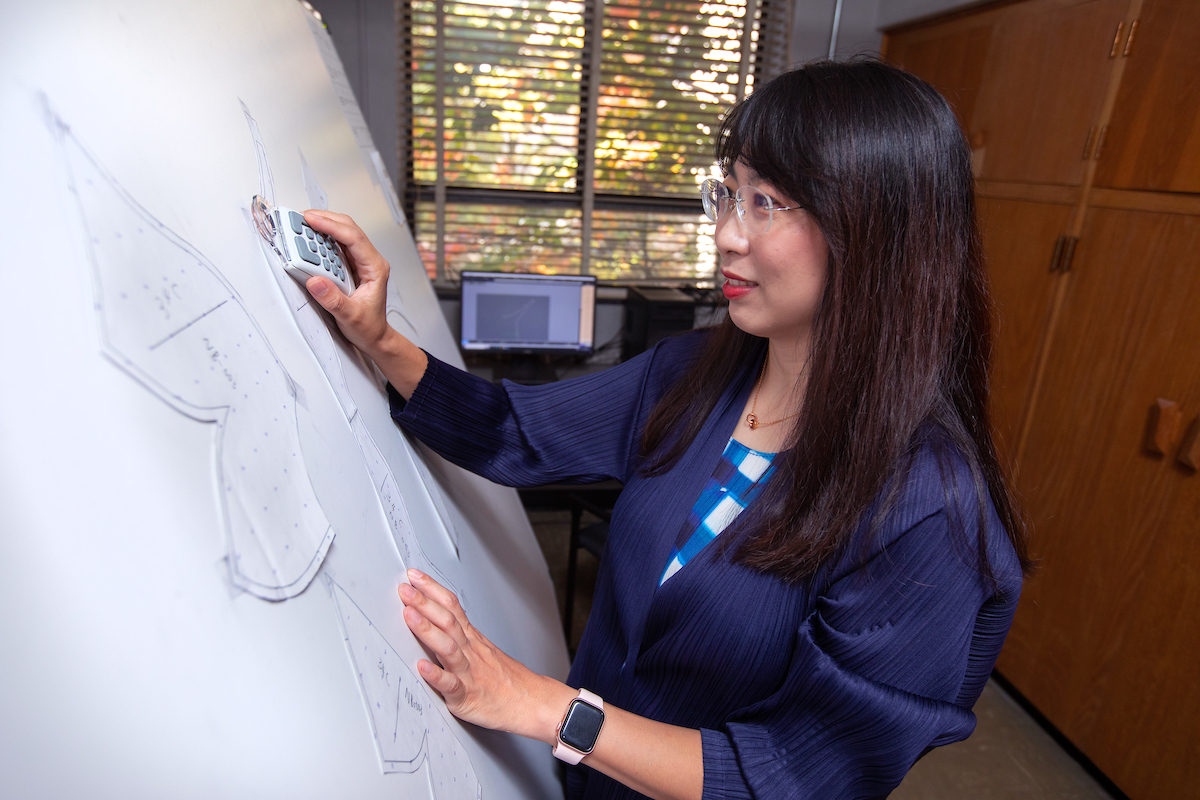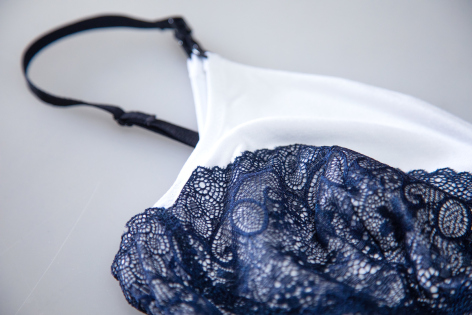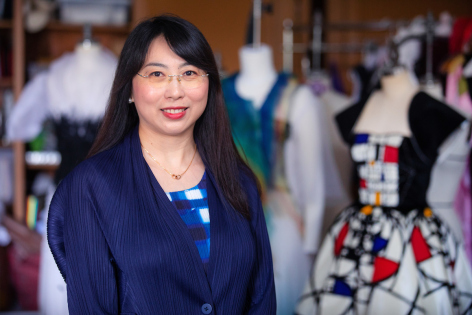
Assistant Professor Ling Zhang uses a garment pattern digitizer to develop her prototypes. Larger image. Photos by Christopher Gannon/Iowa State University
AMES, IA – In a design lab at Iowa State University, Ling Zhang emerges from a forest of mannequins. The assistant professor of apparel, events and hospitality management is carrying two nursing bras and a camisole. They're prototypes Zhang designed and are part of a business she's launching to help new and expecting mothers.
The pieces are soft and trimmed with lace. Zhang runs her hand across the camisole’s purple-ombre fabric, explaining it's made from bamboo. It's cooler than cotton – a small but helpful detail since mothers have warmer body temperatures in the months after giving birth.
Zhang explains she uses her pattern-making skills and the strength of certain fabrics to provide support rather than elastic or underwire. She demonstrates multiple ways to open the prototypes and points to thin strips of ultra-soft Velcro that allow the wearer to easily modify the fit.

One of the nursing bra prototypes.
During pregnancy and breastfeeding, people fluctuate in weight, and it’s normal to change cup sizes, says Zhang. But most bras have limited adjustment options.
“There are a lot of ill-fitting bras on the market. Along with being uncomfortable, they can cause serious health problems for mothers,” says Zhang.
Plastic boning, underwire and other stiff materials around the chest can block milk ducts and lead to mastitis, a painful infection in mammary tissue.
While Zhang had five years of experience as a professional bra designer before her Ph.D. in apparel design, she says she became much more aware of the challenges and limited options with maternity and nursing garments once she had her son. That was a decade ago. She assumed the selection would be better when her daughter was born in 2020 but found it was even worse.
"I thought, why don’t I design a good bra for nursing mothers, using my research in functional apparel design and experience as a professional in the industry,” says Zhang.
Research-based designs
Before designing her prototypes, Zhang analyzed dozens of nursing bras on the market and hired a national survey service to poll around 1,300 participants who were breastfeeding or had recent experience. They shared their preferences for nursing bras, including price, color and brand, and satisfaction with options on the market.
The participants identified comfort and fit as their top priorities, but Zhang shared there were also a lot of comments that nursing bras were ugly and only available in neutral colors.
“Clothing companies often think new mothers don’t need beautiful garments, but they do,” says Zhang. “Many are struggling with seeing their bodies change a lot; some may have stretch marks and want to cover them. They aren’t sleeping as much with a newborn baby.”

Assistant Professor Ling Zhang. Larger image.
To find out if she needs to make any tweaks to her designs before large-scale production begins this winter, Zhang and several students are analyzing results from a recently completed wear trial. Seven participants wore and washed each garment for a week and completed detailed surveys about the comfort, fit, practicality and aesthetic.
Zhang’s goal is to sell the nursing bras and camisole starting in 2024 through her newly registered and trademarked company MUQIN LLC. Her long-term vision for MUQUIN, which means “mother” in Mandarin, is to offer a wide range of nursing and maternity garments and get her products on department store shelves across the U.S.
“Sometimes I question myself,” says Zhang. “Should I do this? Do I have time to do this? But there's a huge gap in this industry, and my goal is to use my experience, my knowledge to help people.”
Tapping into resources at ISU
Zhang says she wouldn't be where she is today without resources and collaboration at ISU.
Initial funding to do her market research and develop prototypes came from the College of Human Science’s Early Career Faculty Research Seed Grant.
During the 2022 spring semester, Zhang participated in the Iowa State I-Corps program, which is part of the Great Lakes Region I-Corps Hub funded by the National Science Foundation. The five-week curriculum helps faculty, postdoctoral, graduate and undergraduate students explore the commercial potential of their research and technology. Upon completion, Zhang received a mini-grant from the ISU I-Corps program.
Zhang also worked with the ISU Office of Innovation Commercialization/ISURF to file a patent for her three products. While it will be the first patent for the College of Human Sciences, Iowa State ranks among the top 100 universities in the world with U.S. utility patents, according to the National Academy of Inventors’ 2021 report.
This fall, Zhang was awarded a $50,000 grant from the Regents Innovation Fund and joined the ISU Startup Factory, a program under the ISU Pappajohn Center for Entrepreneurship. The 18-week program is designed as a startup incubator for entrepreneurs in Iowa. A cohort of 8-12 participants attend workshops twice a week on topics that include discovering customers, developing a commercialization plan and seeking additional capital. Participants also tap into a network of mentors.